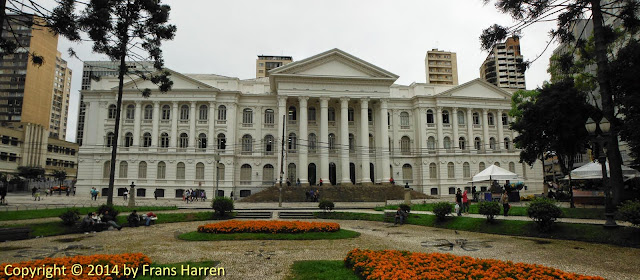
Federal University of Paraná
The Federal University of Paraná is a public university headquartered in Curitiba, Paraná, Brazil.
Nowadays, its facilities are scattered over the capital Curitiba and other cities of the State of Paraná. It offers 124 undergraduate degree courses, 44 doctorate, 66 masters and 5 professional masters programs, apart from a number of lato sensu programs (mostly paid one-year specializations) - see Higher-ed degrees in Brazil. Since 2004, the University has been adopting in its vestibular a program in which twenty percent of the spots offered are destined to students coming from public schools and another twenty percent are reserved for Afro-Brazilians.
UFPR ranks among the 651-700 best universities in the world and 37th best in Latin-America, according to QS World University Rankings. It is placed as the 9th best in the country in the latest "Ranking Universitário Folha (RUF)", published by the nation's largest newspaper.
History
In 1892, José Francisco da Rocha Pombo, an intellectual of the state of Paraná would have initiated the construction of the University, but his project was frustrated by the Federalist Movement.
Twenty years later, Paraná had a reduced number of intellectuals (nine doctors and four engineers), but it was in true development because of the production of the yerba mate.
Moreover, at this time, the Contestado War appeared as an incentive to the efforts of political leaderships concerning the creation of a university. In this context, Victor Ferreira do Amaral, deputy and director of public instruction of Paraná, started the effective creation of the University.
On December 19, 1912 the University was established and, in 1913, it has initiated its activities as a private institution in an old building situated on Comendador Araújo street. The first courses offered were Juridical and Social Sciences, Engineering, Medicine and Surgery, Commerce, Dentistry, Pharmacy and Obstetrics. After the establishment of the University, Victor Ferreira do Amaral, who was also its first president, initiated the construction of a central building in a land donated by the municipal government.
Due to the economic recession caused by the World War I, difficulties started to appear. In 1920, a federal law determined the closing of all universities. In a contradictory measure, the federal government created the Universidade do Rio de Janeiro, currently Universidade Federal do Rio de Janeiro (Federal University of Rio de Janeiro). The alternative to this law was to split the UFPR in several colleges.
Throughout several years, efforts in order to restore the university took place. Only in the beginning of the fifties the colleges were reunited once again in the University of Paraná, its federalization happening just after that, in 1951, when the university became a public and free-of-charge institution.
After its federalization, a process of expansion began with the construction of the Clinic's Hospital (Portuguese: Hospital de Clínicas da Universidade Federal do Paraná) in 1953, the Reitoria Campus in 1958 and the Polytechnic Center in 1961.
Historical Building
The construction placed in the Santos Andrade Square began to be built in 1913, being a project of the military engineer Baeta de Faria. Its inauguration occurred in 1915.
Seven years later, in 1923, two lateral parts were added, according to the original project. The building of the right sector was ended in 1925 and was designated to the Engineering graduation course. In the following year, the left sector had been finalized and it passed to serve the Dentistry course. Other additions were made to the right side of the building and it has received in its totality new paint in 1940. The building was extended towards XV de Novembro Street and, in 1952, new works in the right section led to the demolition of part of the lateral façade built in 1940.
In 1954, the building occupied a whole block between the Santos Andrade Square, XV de Novembro Street, Presidente Faria Street and Alfredo Bufren Lane. The last modifications were made: a new façade with several columns and a wide set of staircases were projected and the covered dome was eliminated. The inauguration of the neoclassical, 17,000 square meter building, took place in 1955.
In the year on 1999, the mayor of Curitiba signed a law that made this building the official symbol of the city.
See: wikipedia











0 comments:
Post a Comment